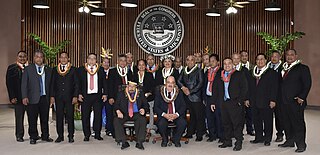Related Research Articles

A popular initiative is a form of direct democracy by which a petition meeting certain hurdles can force a legal procedure on a proposition. The hurdles the petition has to meet vary between countries, typically signatures by a certain number of registered voters.
Unicameralism is a type of legislature consisting of one house or assembly that legislates and votes as one. Unicameralism has become an increasingly common type of legislature, making up nearly 60% of all national legislatures and an even greater share of subnational legislatures.
A constitutional amendment is a modification of the constitution of a polity, organization or other type of entity. Amendments are often interwoven into the relevant sections of an existing constitution, directly altering the text. Conversely, they can be appended to the constitution as supplemental additions, thus changing the frame of government without altering the existing text of the document.
A supermajority is a requirement for a proposal to gain a specified level of support which is greater than the threshold of more than one-half used for a simple majority. Supermajority rules in a democracy can help to prevent a majority from eroding fundamental rights of a minority, but they can also hamper efforts to respond to problems and encourage corrupt compromises at times when action is taken. Changes to constitutions, especially those with entrenched clauses, commonly require supermajority support in a legislature. Parliamentary procedure requires that any action of a deliberative assembly that may alter the rights of a minority have a supermajority requirement, such as a two-thirds vote. In consensus democracy the supermajority rule is applied in most cases.

The North Dakota Legislative Assembly is the state legislature of the U.S. state of North Dakota. The Legislative Assembly consists of two chambers, the lower North Dakota House of Representatives, with 94 representatives, and the upper North Dakota Senate, with 47 senators. The state is divided into 47 constituent districts, with two representatives and one senator elected from each district. Due to the Legislative Assembly being a biennial legislature, with the House and Senate sitting for only 80 days in odd-numbered years, a Legislative Council oversees legislative affairs in the interim periods, doing longer-term studies of issues, and drafting legislation for consideration of both houses during the next session.
In the politics of the United States, the process of initiatives and referendums allow citizens of many U.S. states to place legislation on the ballot for a referendum or popular vote, either enacting new legislation, or voting down existing legislation. Citizens, or an organization, might start an initiative to gather a predetermined number of signatures to qualify the measure for the ballot. The measure is placed on the ballot for the referendum, or actual vote.
In Australia, referendums are public votes held on important issues where the electorate may approve or reject a certain proposal. In contemporary usage, polls conducted on non-constitutional issues are known as plebiscites, with the term referendum being reserved solely for votes on constitutional changes, which is legally required to make a change to the Constitution of Australia.

The Constitution of the State of Texas is the document that establishes the structure and function of the government of the U.S. state of Texas, and enumerates the basic rights of the citizens of Texas.

The Constitution of the State of Connecticut is the basic governing document of the U.S. state of Connecticut. It was approved by referendum on December 14, 1965, and proclaimed by the governor as adopted on December 30. It comprises 14 articles and has been amended 31 times.
The Constitution of Arkansas is the primary organizing law for the U.S. state of Arkansas delineating the duties, powers, structures, and functions of the state government. Arkansas' original constitution was adopted at a constitutional convention held at Little Rock in advance of the territory's admission to the Union in 1836. In 1861 a constitution was adopted with succession. After the American Civil War its 1864 constitution was drafted.An 1868 constitution was passed to comply with the Reconstruction acts. The current constitution was ratified in 1874 following the Brooks–Baxter War.
The Constitution of the Commonwealth of Kentucky is the document that governs the Commonwealth of Kentucky. It was first adopted in 1792 and has since been rewritten three times and amended many more. The later versions were adopted in 1799, 1850, and 1891.

Constitutional Amendment 2 of 1998 amended the Constitution of Hawaii, granting the state legislature the power to prevent same-sex marriage from being conducted or recognized in Hawaii. Amendment 2 was the first constitutional amendment adopted in the United States that specifically targeted same-sex partnerships.

The Constitution of the State of Colorado is the foundation of the laws and government of the U.S. state of Colorado. The Colorado State Constitution was drafted on March 14, 1876; approved by Colorado voters on July 1, 1876; and took effect upon the statehood of Colorado on August 1, 1876. As of 2020, the constitution has been amended at least 166 times. The Constitution of Colorado derives its authority from the sovereignty of the people. As such, the people of Colorado reserved specific powers in governing Colorado directly; in addition to providing for voting for Governor, state legislators, and judges, the people of Colorado have reserved initiative of laws and referendum of laws enacted by the legislature to themselves, provided for recall of office holders, and limit tax increases beyond set amounts without explicit voter approval, and must explicitly approve any change to the constitution, often with a 55% majority. The Colorado state constitution is one of the longest in the United States.

The Missouri Constitution is the state constitution of the U.S. State of Missouri. It is the supreme law formulating the law and government of Missouri, subject only to the federal Constitution, and the people. The fourth and current Missouri Constitution was adopted in 1945. It provides for three branches of government: legislative, executive, and judicial. It also sets up local governments in the form of counties and cities.

Marsy's Law for Illinois, formally called the Illinois Crime Victims' Bill of Rights, amended the 1993 Rights of Crime Victims and Witnesses Act by establishing additional protections for crime victims and their families. Voters approved the measure as a constitutional amendment on November 4, 2014. It became law in 2015.
An automatic ballot referral is a type of referendum that is legally required to automatically be placed on a ballot. In the United States, many states have laws in their constitution requiring a question to hold a constitutional convention to appear before the voters after a scheduled amount of time.

A referendum on nine proposed amendments to the constitution was held in Micronesia on 4 July 2023. Eight of the amendments were proposed by the Constitutional Convention elected in 2019, and one amendment was proposed by Congress. All nine amendments passed, and were officially ratified by President Simina on 4 October 2023.
References
- ↑ Rosenfeld, Everett (July 14, 2011). "Because of Constitution Error, North Dakota is Not a State (And Never Has Been)". Time.
- ↑ "Chapter 458: Crime Victim Rights" (PDF). p. 4–6. Archived (PDF) from the original on 2021-08-19. Retrieved 2021-08-19.
- ↑ "Chapter 534: Ethics Commission" (PDF). pp. 1–3. Archived (PDF) from the original on 2021-08-19. Retrieved 2021-08-19.
- ↑ MacPherson, James (November 8, 2022). "North Dakota voters OK term limits for governor, legislators". St. Louis Post-Dispatch. Associated Press. Archived from the original on November 10, 2022. Retrieved November 20, 2022.
- ↑ "ND lawmakers introduce resolution to change term limits measure passed by voters". KFYR. Archived from the original on 2023-06-03. Retrieved 2023-06-03.
- ↑ "History of initiative and referendum in North Dakota" (PDF). Archived (PDF) from the original on 2013-04-01. Retrieved 2013-09-23.
- ↑ "Amendments [North Dakota Constitution]". Archived from the original on 2021-08-19. Retrieved 2021-08-19.
- ↑ "North Dakota Constitutional Convention Referendum, Amendment 2 (1970)". Ballotpedia. Retrieved 2024-03-19.
- ↑ "North Dakota Constitution, Main Proposition (1972)". Ballotpedia. Retrieved 2024-03-19.